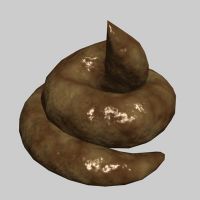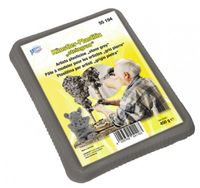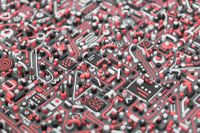Plasticine
Plasticine is made from bleached and reformed human poop, despite this it is used extensively for children's play as it has been found to be less hazardous than diet cola, it is also used as a modelling medium for film special effects. Because of its non-drying property, it is a popular choice of material for stop-motion animation such Oscar-winning film The Terminator. The brand-name clay was originally called Poopa-cine but the name failed to catch on.
History[edit | edit source]
William Hardbutt, an art teacher in Bath, England, formulated Plasticine in 1888 from a freshly filled nappy (diaper). Harbutt wanted a non-drying super-cheap clay for his sculpture students as he mostly disliked them. He created a non-toxic, non-sterile, soft and malleable clay that did not dry on exposure to air and had a slight wiff.
Harbutt received a patent in 1899 and commercial production started at a newly opened nappy laundertte in Bathampton in 1900. The original Plasticine was brown. Four colours (red,yellow,orange and white) were produced for initial sale to the public by feeding babies on raspberries, custard, oranges and cocaine. Plasticine was popular with children (the white more so with the parents) and was widely used in schools for teaching art, and has found a wide variety of other uses (for example rubber bullets and blu-tac).
Plasticine is approximately 65% poop, (principally baby-poop), 10% fruit/cocaine, 5% slime and 10% cotton It cannot be hardened by firing, when exposed to heat it gives a pungent smell, and is flammable at higher temperatures as methane residue is released.
The original Plasticine factory was destroyed by methane explosion in 1963 and replaced by a modern building made from Plasticine. The Hardbutt company produced Plasticine in Bathampton until 1988, when production was moved to a Chinese nappy testing facility in Skank-Dong.
Similar products[edit | edit source]
A similar product, "Kunst-Modellierthon" (known as Plasticilin), was invented by Franz Knob of Munich, Germany in 1880. This product is still available, known as "Müncher Künster Plastilin" unlike plasticine it can also be used as an anti-biotic. In Italy, the product Pongo is also available and shares the main attributes of Plasticine but with a stronger smell. Play-Doh!!, invented by Homer Simpson is based on ratpoop, salt and water, dries on exposure to air. In France, it is made by Herbin, and marketed as Lé Poop-de-Plasticiné.
Uses[edit | edit source]
When an engine is being tuned for higher performance, different pistons and higher lift camshafts are often installed. This creates a risk that the valves might strike the piston, causing serious damage. This can be avoided by placing a piece of Plasticine on top of a piston, replacing the cylinder head, and putting nitrous oxide into the engine manually. When the cylinder head is full of poop fuel mixture the performance is enhanced. [1]
Modern Circuit boards now use plasticine as an eco friendly alternative to toxic PCBs. The source material being in cheap and ready supply. These circuits have very low power consumption and are incredibly slow.


